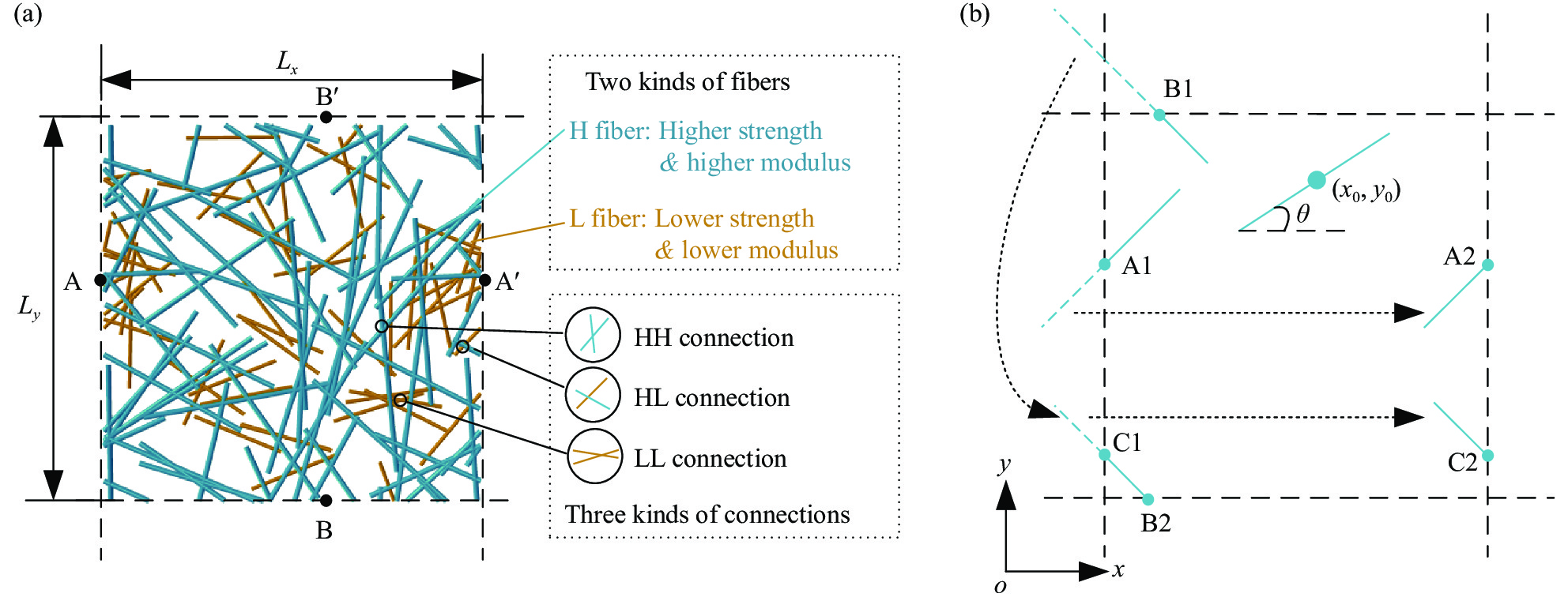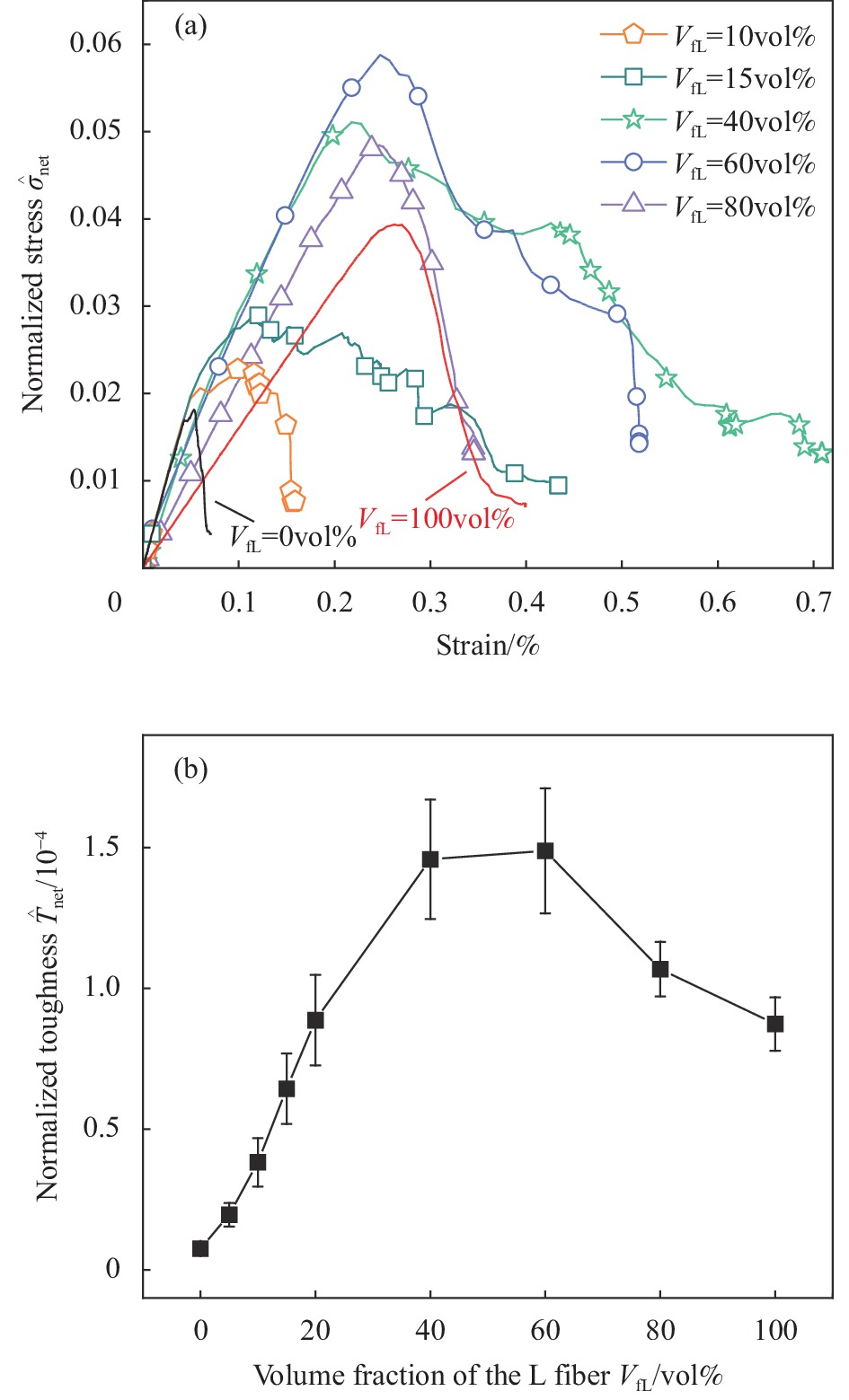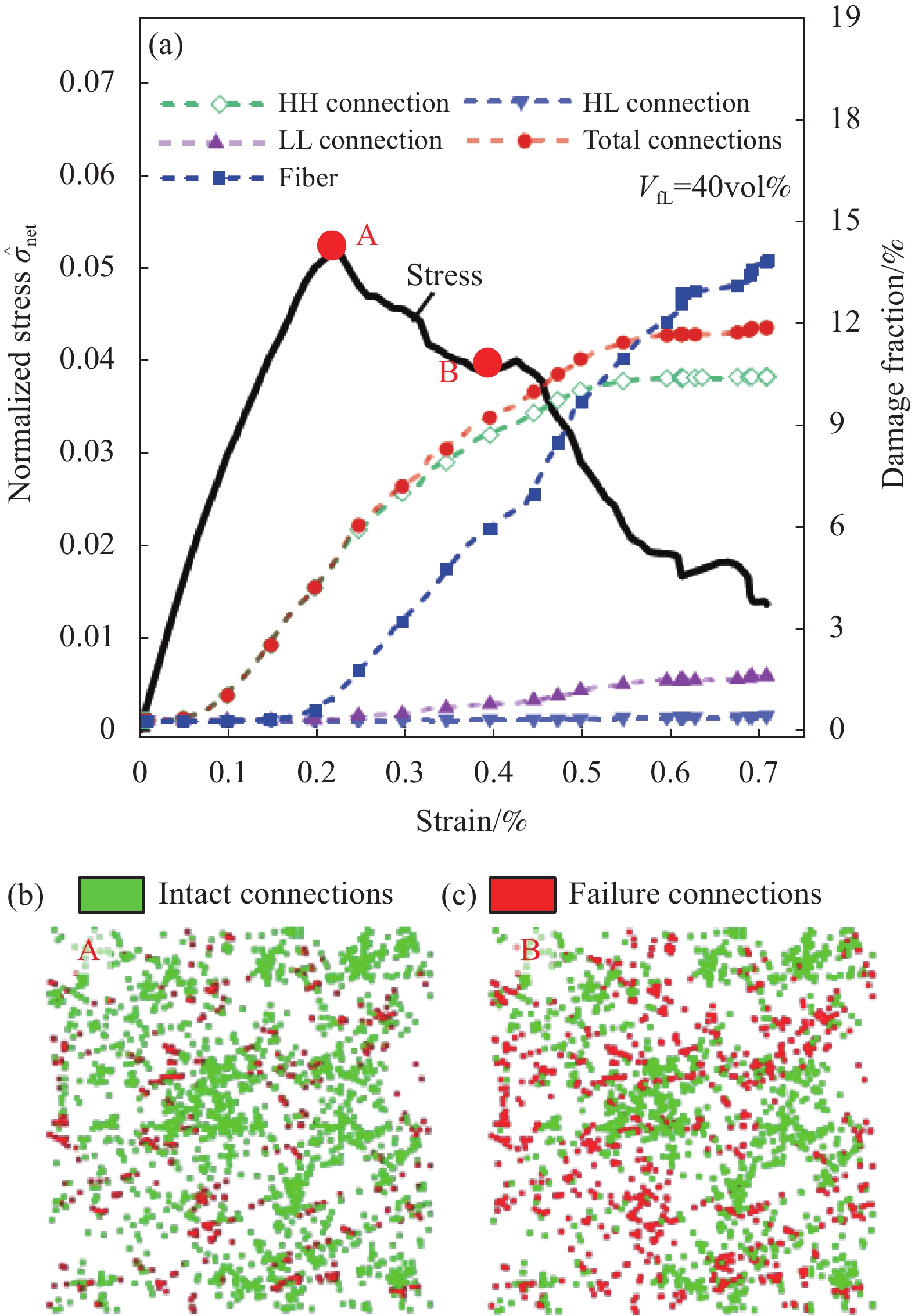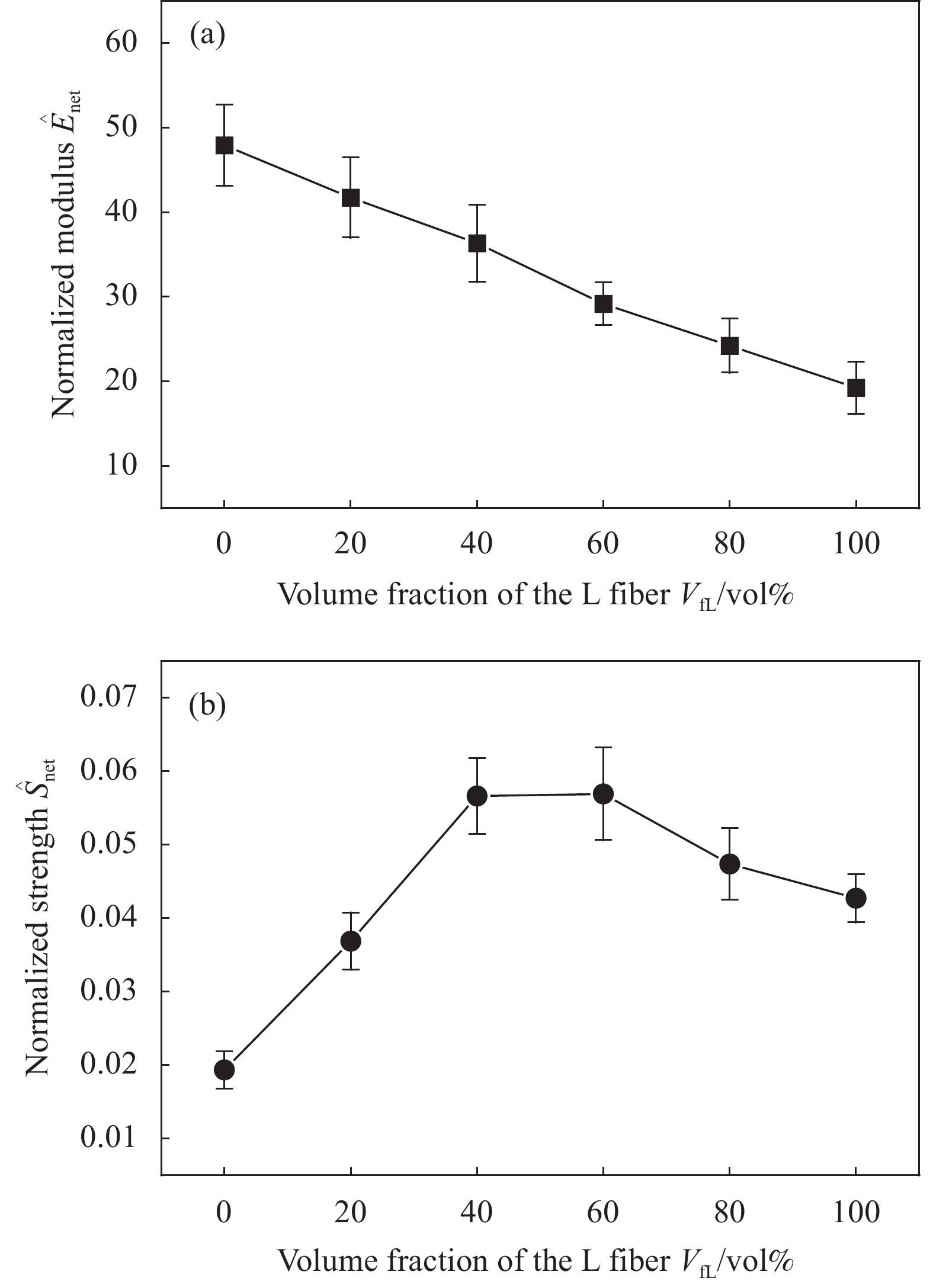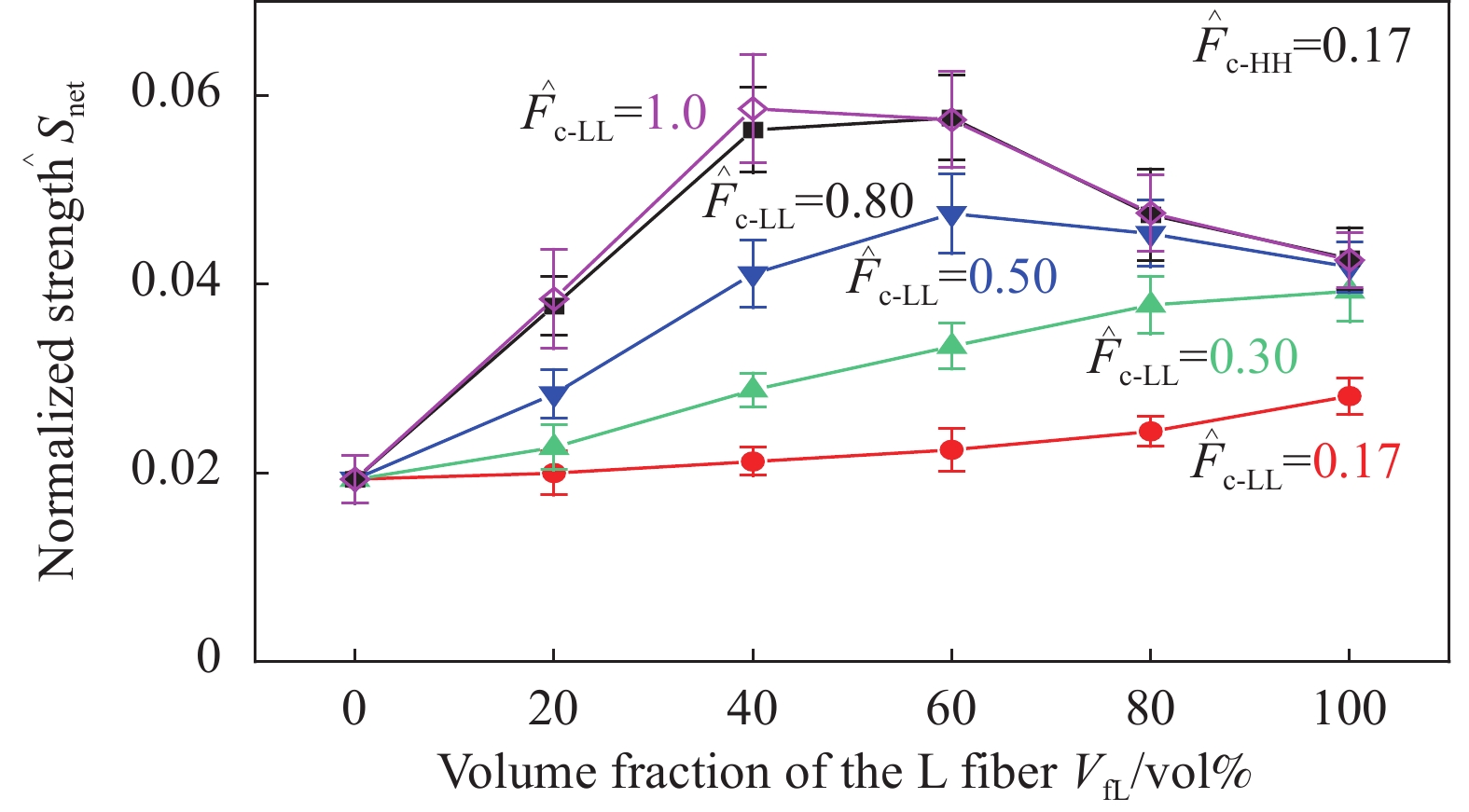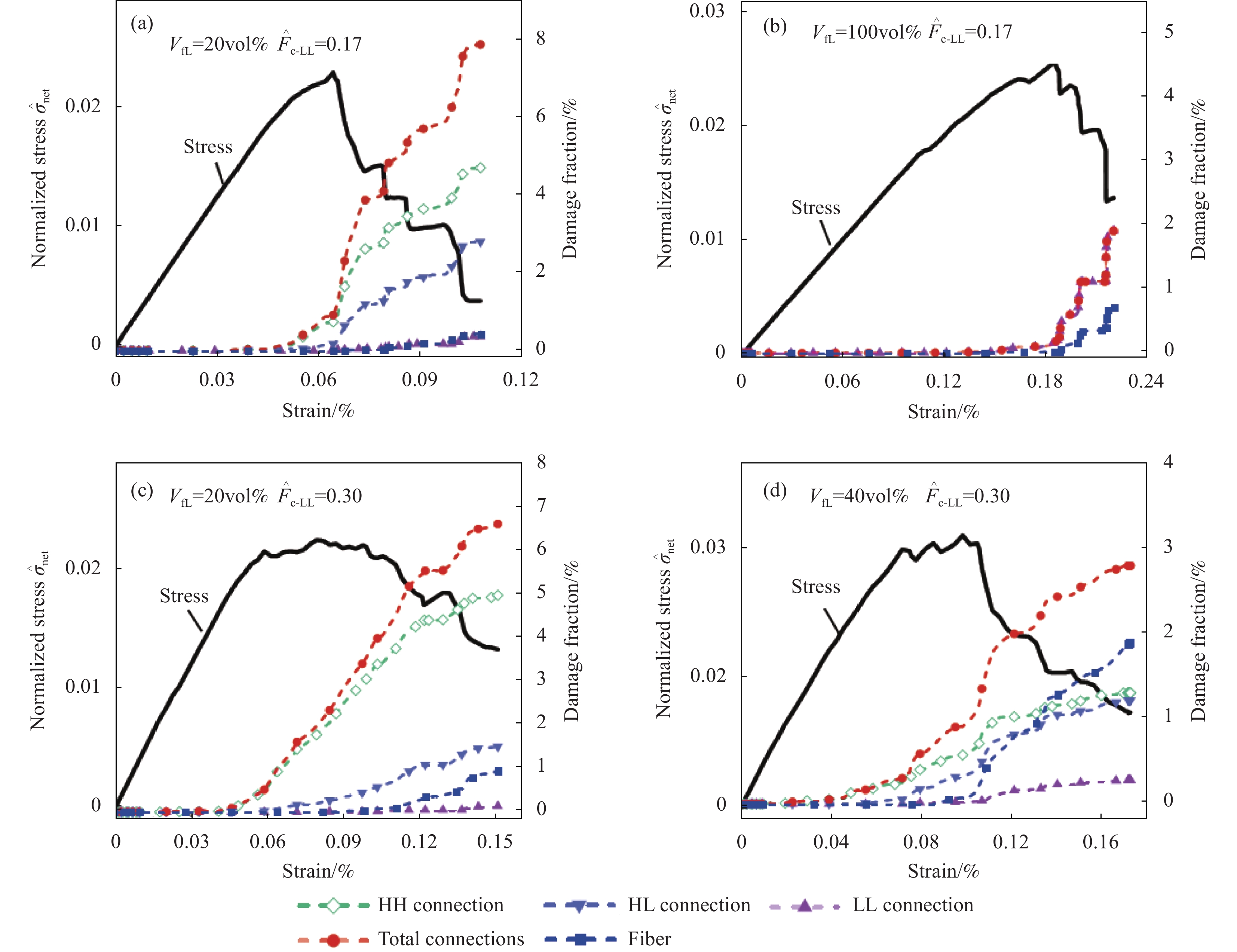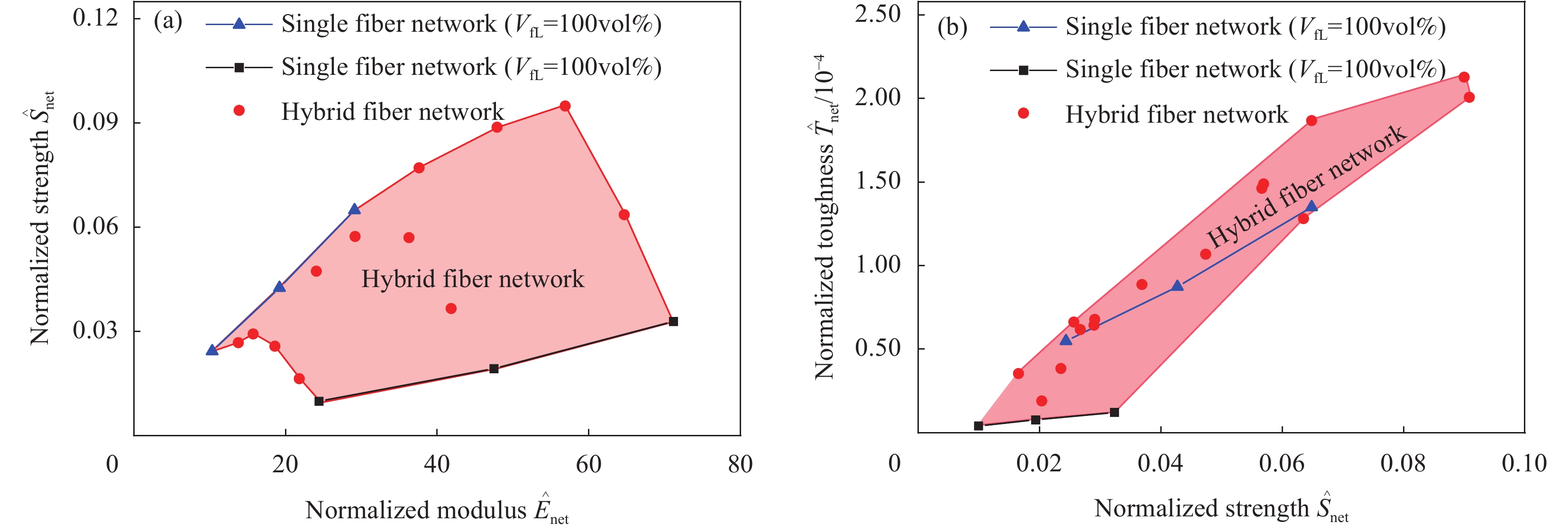Failure mechanism of hybrid fiber networks
-
摘要: 纤维网络材料是一类广泛存在且具有重要应用前景的多功能轻质材料。目前研究主要集中于单一纤维网络材料,但实际应用中大部分纤维网络都是由不同性质纤维构成的混杂纤维网络,其性能和功能的设计空间更大,但失效机制也更复杂。为了进一步提升纤维网络材料的力学性能,深入研究混杂纤维网络的失效过程及失效机制非常重要。为此,本文建立了综合考虑纤维和纤维间连接力学性能的混杂纤维网络模型,系统地研究了混杂纤维网络的失效过程,并讨论分析了纤维混杂比例、纤维间连接强度及纤维总体积分数等因素的影响。结果表明,对于典型混杂纤维网络而言,随着纤维组分的变化,网络的失效存在连接损伤主导、连接与纤维损伤共同主导及纤维损伤主导三类不同的失效模式。其中,由连接和纤维损伤共同主导的失效,损伤分散于整个网络,连接和纤维会表现出协同作用,因此网络具有更好的韧性和强度。由此可见,混杂纤维网络力学性能的设计空间远大于单一纤维网络,具有更广阔的应用前景。Abstract: Fiber network material is a kind of multifunctional lightweight material which exists widely and has important application prospect. At present, researches mainly focus on networks consisting of one type of fibers. However, in practice, most fiber networks are hybrid fiber networks composed of fibers with different properties, which have larger performance and function design space but more complex failure mechanism. In order to further improve the mechanical properties of fiber networks, it is very important to study the failure process and failure mechanism of hybrid fiber networks. Therefore, the hybrid fiber network model was established in this paper to take account of both the mechanical properties of fibers and the inter-fiber connections. Based on the model, the failure process of hybrid fiber networks was systematically studied, and the effects of the fiber mixture ratio, the strength of inter-fiber connections and the total fiber volume fraction were analyzed. The results show that for typical hybrid fiber networks, there are three failure modes: inter-fiber connection dominated failure, inter-fiber connection and fiber co-dominated failure, and fiber dominated failure, with the variation of fiber mixture ratio. When the failure is co-dominated by the connection and fiber damages, the damages disperse throughout the network, and the network presents better toughness and strength. Therefore, the design space of mechanical properties of hybrid fiber network is much larger than that of networks consisting of only one type of fibers, and the hybrid network exhibits a wider application prospect.
-
Keywords:
- hybrid fiber networks /
- composite materials /
- strength /
- toughness /
- failure mechanis
-
纤维增强复合材料具有比强度高、比模量大等优点,已被广泛应用于航空航天等工业领域[1]。但复合材料对冲击敏感性较高,内部受低速冲击后会产生不可见损伤,造成安全隐患。碳纤维-玻璃纤维混杂复合材料是将碳纤维及玻璃纤维在同一种基体内成型的复合材料,可有效提高复合材料的力学性能[2-3]。目前对混杂复合材料低速冲击性能的研究主要集中在混杂结构和纤维种类上[4-5]。Swolfs等[6]研究发现,将低伸长率纤维放在层合板中间位置,可有效提高抗侵彻性能。Hung等[7]分析了碳纤维-玻璃纤维层间混杂复合材料低速冲击性能,发现将碳纤维置于冲击面时抗冲击性能更强。Manikandan等[8]研究发现,将韧性纤维置于复合材料背面可吸收更多冲击能量,原因是由于下部韧性层可为上部脆性层提供更大的变形。Sarasini等[9]对玻璃纤维-玄武岩纤维混杂复合材料进行低速冲击研究表明,玄武岩纤维为芯层的夹芯混杂结构吸收冲击能量更多,玻璃纤维为芯层时弯曲性能较好。有限元分析是分析低速冲击的有效手段,Liu等[10]对比了Puck、Hashin及Chang-Chang失效准则对低速冲击预测的区别,结果表明,三种准则在低速冲击响应和能量耗散方面的预测结果基本一致,在基体和分层损伤的预测上有所不同。Hou等[11]基于连续介质损伤力学(CDM)建立了含修补区域的复合材料低速冲击模型,采用基于断裂韧性的损伤变量,研究了修补区厚度及铺层结构对低速冲击性能的影响。Ebina等[12]对不同铺层结构的碳纤维复合材料进行低速冲击模拟,面内损伤采用增强连续介质力学(ECDM)模型,纤维损伤采用裂缝模型(SCM),层间采用界面单元(CZM),模拟结果与实验数据拟合度较高。Chen等[13]建立了碳纤维-玻璃纤维-玄武岩纤维复合材料低速冲击损伤模型,定义指数型损伤变量,研究发现,碳纤维为芯层的夹芯结构抗冲击性能较好,玄武岩-碳纤维混杂结构与碳纤维-玻璃纤维混杂结构的冲击响应类似。Wu等[14]建立了纱线尺度的三维正交碳纤维-玻璃纤维混杂复合材料低速冲击模型,采用代表性体积单元(RUC)计算复合材料层合板宏观力学参数,研究发现,冲击面为碳纤维时抗冲击性能更好,破坏主要为冲击面碳纤维断裂和上层纤维-基体分层损伤,冲击面为玻璃纤维时破坏主要为复合材料层合板背部分层损伤。由于冲击速度较低,应变率效应不明显,大多数复合材料低速冲击研究会忽略应变率效应[15-16]。部分低速冲击数值模拟研究考虑了应变率效应,Wang等[17]建立了应变率相关的碳纤维复合材料低速冲击三维损伤模型,采用修正的复合材料应力-应变关系及考虑应变率效应的层内层间损伤模型,模拟结果与实验数据拟合程度较好。
本文以碳纤维-玻璃纤维混杂复合材料为研究对象,分析混杂结构和冲击面纤维种类对低速冲击性能的影响。采用商业有限元软件ABAQUS建立了层间和层内两类混杂复合材料低速冲击模型,层内混杂复合材料采用纱线尺度模型。编写VUMAT子程序定义指数型渐进损伤因子及刚度退化方案,考虑纤维断裂、基体开裂、分层等损伤,通过分析实验数据及损伤形貌,揭示了碳纤维-玻璃纤维混杂复合材料低速冲击损伤破坏机制。
1. 实验及仿真方法
1.1 原材料及试样制备
单向经编织物(NCF)采用碳纤维(CF,TORAY T620SC-24K-50C)和玻璃纤维(GF,CPIC ECT469L-2400)制成,包括纯CF和纯GF的NCF织物及两种层内混杂织物,织物规格如表1所示,其中CF-GF和CF-CF-GF-GF为层内混杂织物,织物结构示意图如图1所示。环氧树脂,型号为2511-1A/BS风电叶片真空灌注专用树脂,主剂与固化剂质量比为100∶30,上纬(天津)公司。
表 1 碳纤维-玻璃纤维(CF-GF)单向经编织物(NCF)规格Table 1. Specifications of carbon fiber-glass fiber (CF-GF) non-crimp fabric (NCF)Fabric type Areal density/(g·m−2) Mass ratio of CF to GF CF GF CF 728.3 0 1∶0 GF 0 944.9 0∶1 CF-GF 364.2 472.4 1∶1 CF-CF-GF-GF 364.2 472.4 1∶1 本文设计层间和层内两类混杂结构,层内混杂层合板由CF-GF和CF-CF-GF-GF两种层内混杂织物铺层而成。各层合板的CF-GF混杂比均为1∶1,铺层方式为(0°/90°)4S,共8层,根据混杂结构及冲击面纤维种类进行命名,如表2所示,其中S-C和S-G采用夹芯式层间铺层形式。采用真空辅助树脂传递模塑(VARTM)工艺成型,固化条件为80℃、8 h。
表 2 CF-GF混杂复合材料层合板铺层结构Table 2. Stacking configurations of CF-GF hybrid composite laminatesHybrid structure Stacking sequence Nomenclature Non-hybrid (CFCFCFCF)2s C (GFGFGFGF)2s G Interply-hybrid (CFGFCFGF)2s I-C (GFCFGFCF)2s I-G Sandwich-hybrid (CFCFGFGF)2s S-C (GFGFCFCF)2s S-G Intralayer-hybrid (CF-GF) fabric CN-1 (CF-CF-GF-GF) fabric CN-2 1.2 性能测试
按照ASTM D7136M—05[18],采用INSTRON-9250HV落锤试验机进行低速冲击实验,通过改变冲击速度控制冲击能量,设置两个冲击能量分别为30 J和50 J,试样尺寸为100 mm×150 mm×6 mm,每组测试5个试样。利用NAUT21空气耦合式超声波C扫监测复合材料冲击后分层损伤,采用Bruker SkyScan1072进行Micro-CT测试,观察内部损伤形貌。
1.3 有限元模型
1.3.1 复合材料损伤准则
Hashin失效准则被广泛应用于分析预测复合材料损伤破坏[19],但复合材料在损伤过程中冲击点附近的应力变化剧烈,应力形式的Hashin失效准则无法准确描述材料破坏过程,而应变在冲击过程中的变化较为平缓,更适合作为复合材料的失效判据。因此,本文采用基于应变形式的Hashin失效准则[20],具体表达式如下:
纤维拉伸断裂 (
ε11⩾ ):{e}_{\rm{f}}^{\rm{t}}={\left(\frac{{\varepsilon }_{11}}{{\varepsilon }_{11}^{\rm{T}}}\right)}^{2}+{\left(\frac{{\varepsilon }_{12}}{{\tau }_{12}}\right)}^{2}+{\left(\frac{{\varepsilon }_{13}}{{\tau }_{13}}\right)}^{2}\geqslant 1 (1) 纤维压缩断裂 (
{\varepsilon }_{11}\leqslant 0 ):{e}_{\rm{f}}^{\rm{c}}={\left(\frac{{\varepsilon }_{11}}{{\varepsilon }_{11}^{\rm{C}}}\right)}^{2}\geqslant 1 (2) 基体拉伸断裂(
{\varepsilon }_{22}\geqslant 0 ):{e}_{\rm{m}}^{\rm{t}}={\left(\frac{{\varepsilon }_{22}}{{\varepsilon }_{22}^{\rm{T}}}\right)}^{2}+{\left(\frac{{\varepsilon }_{12}}{{\tau }_{12}}\right)}^{2}+{\left(\frac{{\varepsilon }_{23}}{{\tau }_{23}}\right)}^{2}\geqslant 1 (3) 基体压缩断裂(
{\varepsilon }_{22}\leqslant 0 ):\begin{split} e_{\rm{m}}^{\rm{c}} = &{\left( {\frac{{{E_{22}}{\varepsilon _{22}}}}{{2{G_{12}}{\gamma _{12}}}}} \right)^2} + {\left( {\frac{{{\varepsilon _{22}}}}{{\varepsilon _{22}^{\rm{T}}}}} \right)^2}\left[ {\left( {{{\left( {\frac{{{E_{22}}\varepsilon _{22}^{\rm{C}}}}{{2{G_{12}}{\tau _{12}}}}} \right)}^2} - 1} \right)} \right] + \\& {\left( {\frac{{{\varepsilon _{12}}}}{{{\tau _{12}}}}} \right)^2} + {\left( {\frac{{{\varepsilon _{13}}}}{{{\tau _{13}}}}} \right)^2} \geqslant 1 \end{split} (4) 式中:E和G分别为材料的杨氏模量和剪切模量;
{\varepsilon }_{11} 和{\varepsilon }_{22} 为单元材料主方向的应变分量;{\varepsilon }_{12} 、{\varepsilon }_{13} 和{\varepsilon }_{23} 为单元材料主方向的剪切应变分量;{\varepsilon }_{{{i}}{{i}}}^{\rm{T}} 和{\varepsilon }_{{{i}}{{i}}}^{\rm{C}} 分别为i 方向对应的拉伸和压缩强度的失效应变;{\tau }_{{{i}}{{j}}} 为单元剪切强度对应的剪切失效应变。当某单元内应变分量满足上述某一条件时,即认为该单元发生损伤。失效应变与材料强度之间的关系如下:\begin{split} &{X_{\rm{T}}} = {E_{11}}\varepsilon _{11}^{\rm{T}},{X_{\rm{C}}} = {E_{11}}\varepsilon _{11}^{\rm{C}},{Y_{\rm{T}}} = {E_{22}}\varepsilon _{22}^{\rm{T}},\\ &{Y_{\rm{C}}} = {E_{22}}\varepsilon _{22}^{\rm{C}},{Z_{\rm{T}}} = {E_{33}}\varepsilon _{33}^{\rm{T}},{S_{12}} = {G_{12}}{\tau _{12}},\\ &{S_{13}} = {G_{13}}{\tau _{13}},{S_{23}} = {G_{23}}{\tau _{23}} \end{split} (5) 式中,
{X}_{\rm{T}} 、X_{\rm{C}} 、Y_{\rm{T}} 、Y_{\rm{C}} 、{S}_{{{i}}{{j}}} 分别为层合板轴向拉伸、轴向压缩、横向拉伸、横向压缩和各方向的剪切强度。相关材料属性如表3和表4所示。表 3 用于数值模拟的CF/2511-1A/BS环氧树脂复合材料和GF/2511-1A/BS环氧树脂复合材料弹性参数Table 3. Elastic parameters of CF/2511-1A/BS epoxy composites and GF/2511-1A/BS epoxy composites used in numerical simulationMaterial E11/GPa E22=E33/GPa G12=G13/GPa G23/GPa {\mu }_{12} {\mu }_{13} {\mu }_{23} {G}_{{\rm{f}}}/(kJ·m−2) {G}_{{\rm{m}}}/(kJ·m−2) CF/epoxy 110 8.3 4.6 3.4 0.303 0.303 0.38 80 1 GF/epoxy 40 8.4 4.3 3.2 0.315 0.315 0.39 65 1 Notes: E11, E22, E33—Elastic modulus (direction 11, 22, 33); G12, G13, G23—Shear modulus (direction 12, 13, 23); {\mu }_{12} , {\mu }_{13} , {\mu }_{23} —Poisson’s ratio (direction 12, 13 and 23). 表 4 用于数值模拟的CF/2511-1A/BS环氧树脂复合材料和GF/2511-1A/BS环氧树脂复合材料的强度参数Table 4. Strength parameters of CF/2511-1A/BS epoxy composites and GF/2511-1A/BS epoxy composites used in numerical simulationMPa Material XT XC YT=ZT YC=ZC S12=S13 S23 CF/epoxy 1600 640 48 150 80 60 GF/epoxy 860 550 48 140 65 60 单元产生损伤后需进行材料性能退化,即刚度折减,本文引入指数形式的损伤状态变量d定义渐进损伤刚度折减方案。相比于参数型损伤变量将材料宏观属性直接折减,指数型损伤变量更接近实际情况且损伤过程连续[21]。将Hashin准则中的失效因子(
{e}_{\rm{f}} 、{e}_{\rm{m}} )与损伤变量({d}_{\rm{f}} 、{d}_{\rm{m}} )相关联,具体形式如下:[22],\begin{array}{l} {d_{\rm{f}}} = 1 - \dfrac{1}{{\sqrt {{e_{\rm{f}}}} }}{{\rm{e}}^{\left( { - {E_{11}}{{\left( {\varepsilon _{11}^{{{{\rm{f}}i}}}} \right)}^2}\left( {\sqrt {{e_{\rm{f}}}} - 1} \right){L^{\rm{c}}}/{G_{\rm{f}}}} \right)}}\\ {d_{\rm{m}}} = 1 - \dfrac{1}{{\sqrt {{e_{\rm{m}}}} }}{{\rm{e}}^{\left( { - {E_{22}}{{\left( {\varepsilon _{22}^{{{{\rm{m}}i}}}} \right)}^2}\left( {\sqrt {{e_{\rm{m}}}} - 1} \right){L^{\rm{c}}}/{G_{\rm{f}}}} \right)}} \end{array} (6) 式中:
{G}_{\rm{f}} 和{G}_{\rm{m}} 分别为材料纤维纵向和横向断裂韧性;{L}^{\rm{c}} 为单元特征长度,加入{L}^{\rm{c}} 可降低网格密度对结果精度的影响;i 根据单元受拉或受压分别赋值为T 或C 。本文采用的刚度退化方案如下:\begin{split} &{C}_{11}^{{\rm{d}}}=\left(1-{d}_{\rm{f}}\right){C}_{11} \\ &{C}_{22}^{{\rm{d}}}=\left(1-{d}_{\rm{f}}\right){\left(1-{d}_{\rm{m}}\right)C}_{22} \\ &{C}_{33}^{{\rm{d}}}=\left(1-{d}_{\rm{f}}\right){\left(1-{d}_{\rm{m}}\right)C}_{33} \\ &{C}_{12}^{{\rm{d}}}=\left(1-{d}_{\rm{f}}\right){\left(1-{d}_{\rm{m}}\right)C}_{12} \\ &{C}_{23}^{{\rm{d}}}=\left(1-{d}_{\rm{f}}\right){\left(1-{d}_{\rm{m}}\right)C}_{23} \\ &{C}_{13}^{{\rm{d}}}=\left(1-{d}_{\rm{f}}\right){\left(1-{d}_{\rm{m}}\right)C}_{13} \end{split} (7) 采用双线性内聚力单元(Cohesive element)模拟相邻子层界面的分层损伤[23]。采用二次应力损伤准则(Quads)定义损伤起始,损伤演化采用B-K (Benzeggaph-Kenane)准则,分别如下:
{\left(\frac{{t}_{{\rm{n}}}}{N}\right)}^{2}+{\left(\frac{{t}_{{\rm{s}}}}{S}\right)}^{2}+{\left(\frac{{t}_{\rm{t}}}{T}\right)}^{2}=1 (8) {G}^{\rm{C}}\geqslant {G}_{{\rm{n}}}^{\rm{C}}+\left({G}_{{\rm{S}}}^{\rm{C}}-{G}_{{\rm{n}}}^{\rm{C}}\right){\left(\frac{{G}_{{\rm{s}}}}{{G}_{\rm{T}}}\right)}^{\eta } (9) 式中:
{t}_{{\rm{n}}} 、{t}_{{\rm{s}}} 、{t}_{\rm{t}} 分别为界面法向应力和两个剪切应力;N、S、T对应界面法向和两个剪切强度;{G}_{{\rm{n}}}^{\rm{C}} 和{G}_{{\rm{S}}}^{\rm{C}} 分别为法向和切向临界应变能释放率;{G}_{{\rm{s}}} 和{G}_{{\rm{n}}} 分别为{t}_{{\rm{s}}} 、{t}_{{\rm{n}}} 对应的能量释放率。相关材料属性如表5所示。表 5 CF/2511-1A/BS环氧树脂复合材料和GF/2511-1A/BS环氧树脂复合材料的层间界面参数Table 5. Material properties of interface cohesive elements for CF/2511-1A/BS epoxy composites and GF/2511-1A/BS epoxy compositesρ/(kg·m−3) kN/(GPa·mm−1) kS=kT/(GPa·mm−1) N/MPa S=T/MPa G_{\rm{n}}^{\rm{C}}/(J·m−2) G_{\rm{S}}^{\rm{C}}/(J·m−2) η 1200 15 1.2 30 60 0.28 0.8 1.5 1.3.2 层间/层内数值模拟模型
图2为层间及夹芯混杂复合材料低速冲击模型,层合板采用沙漏增强模式的减缩积分单元C3D8R,共8层,单层尺寸为150 mm×100 mm×0.75 mm,定义X轴为纤维方向,Y轴为基体方向,通过改变每层材料属性实现相应的混杂结构。界面为0厚度的COH3D8内聚力单元,共7层。夹具是内径为120 mm、宽为10 mm的圆环,冲头是直径为12.6 mm的半球形锤头,夹具和冲头定义为刚体,采用R3D4单元。细化层合板冲击区域网格,提高模拟精准度。
层内混杂复合材料采用纱线尺度模型,层合板、夹具和冲头尺寸与层间模型一致,如图3(a)所示。模型假设树脂对纤维完全浸润,复合材料中纱线系统以纤维束增强树脂的复合形式存在,纤维与树脂为一整体[24],单根纱线横截面尺寸为5 mm×0.75 mm,如图3(b)所示,通过改变每根纤维束材料属性,实现CN-1及CN-2混杂结构,复合材料的基体部分由布尔运算得到,如图3(c)所示。采用金相显微镜观察纤维分布情况如图4(a)和图4(b)所示,测得CF体积分数为68vol%,GF体积分数为70vol%,在ABAQUS中建立四边形RUC (Representative unit cell)单元[25],如图4(c)所示,计算纤维束增强树脂弹性参数,相关属性如表6和表7所示。
表 6 CF-GF层内混杂增强环氧树脂复合材料模型中CF、GF和2511-1A/BS环氧树脂的材料参数Table 6. Material paramenters of CF, GF and 2511-1A/BS epoxy for CF-GF intralayer hybrid reinforced epoxy composite modelMaterial E11/GPa E22=E33/GPa G12=G13/GPa G23/GPa {\mu }_{12} {\mu }_{13} {\mu }_{23} \rho /(kg·m−3) CF 234 20 9.2 7.4 0.3 0.3 0.34 1.77 GF 78.7 7 4.0 2.5 0.3 0.3 0.4 2.54 2511-1A/BS epoxy 3.1 — — — 0.3 — — 1.13 表 7 CF-GF层内混杂增强环氧树脂复合材料模型中CF和GF纤维束的力学性能Table 7. Mechanical properties of CF and GF fiber bundle for CF-GF intralayer hybrid reinforced epoxy composite modelMaterial E11/GPa E22=E33/GPa G12=G13/GPa G23/GPa μ12 μ13 μ23 CF fiber bundle 153 8.70 3.60 3.20 0.3 0.3 0.36 GF fiber bundle 52 5.27 2.48 1.88 0.3 0.3 0.40 2. 结果与讨论
2.1 CF-GF混杂增强环氧树脂复合材料低速冲击实验结果
极限载荷和吸收能量是表征低速冲击性能的主要数据。图5为CF-GF混杂增强环氧树脂复合材料的极限载荷和吸收能量。可以发现,不同能量下CF-GF混杂增强环氧树脂复合材料的极限载荷不同,CF-GF混杂增强环氧树脂复合材料50 J冲击能量的极限载荷较30 J冲击能量下更高,这是由于在同样配比下,较大的冲击能量对应更快的冲击速度,撞击时的应变率效应更明显[26]。其中,G结构抗冲击性能最弱,S-C结构吸收能量较大,I-C和CN-1结构极限载荷较高。随着能量的增加,极限载荷和吸收能量均增大,混杂结构可提高极限载荷和吸收能量。冲击面为CF时,极限载荷和吸收能量均较高。I-C结构极限载荷最高,相较于G结构提高了24%。I-G和S-G结构的极限载荷相差不大,均较小。两种层内混杂结构呈现出较高的极限载荷,相较于G结构提高了20%左右。冲击面纤维种类相同时,夹芯(S-C和S-G)结构的吸收能量大于层间混杂(I-C和I-G)结构。相同混杂结构中,冲击面为CF时吸收能量较大,S-C结构的吸收能量较C结构和G结构分别提高了10%和16%。CN-2结构的吸收能量大于CN-1结构,与面内混杂界面的分布有关系[27]。
2.2 CF-GF混杂增强环氧树脂复合材料低速冲击有限元结果
2.2.1 实验与数值模拟结果对比
图6为30 J能量冲击下C结构、I-C结构、S-G结构和CN-1结构的CF-GF混杂增强环氧树脂复合材料时间-载荷和时间-能量曲线。可知,极限载荷模拟结果略大于实验值,能量模拟数据略低。实验曲线随时间变化趋势与模拟曲线结果拟合度较高。
2.2.2 低速冲击损伤形态及破坏机制
图7为50 J能量冲击后CF-GF混杂增强环氧树脂复合材料C扫描及分层失效模拟(SDEG)结果。图8为50 J能量冲击后CF-GF混杂增强环氧树脂复合材料的分层损伤面积。图9为CF-GF混杂增强环氧树脂复合材料目视及模拟冲击面纤维损伤结果(SDV1)。图10为CF-GF混杂增强环氧树脂复合材料冲击背面基体目视损伤及数值模拟结果(SDV2)。可知,模拟结果与实验损伤形貌较一致,冲击面为CF (C、I-C、S-C)时,分层面积为菱形,纤维损伤沿Y方向,I-C结构背部基体损伤较少,S-C结构背部基体损伤区域较大且分层面积最大。冲击面为GF (G、I-G、S-G)时,分层面积接近椭圆形,纤维损伤集中于冲击点下方,冲击面损伤呈圆圈状,冲击背面表现为菱形损伤,I-G结构与S-G结构背面基体破坏形貌类似,I-G结构分层面积最小。层内混杂结构的冲击面纤维损伤形貌与C结构类似,但面内损伤传播连续性较低,CF纤维束内SDV1损伤较GF纤维束集中,且沿X轴有横向扩散,在远离冲击点处仍可观察到部分CF纤维束内SDV1失效,而相邻GF纤维束未出现破坏。SDV2损伤由冲击点正下方向四周扩散,经混杂界面后损伤程度明显降低,大多数损伤发生在CF纤维束内,说明CF纤维束对相邻的GF纤维束有保护作用。CN-1结构的纤维损伤较CN-2结构低,纤维束内基体损伤较CN-2高,混杂界面对面内损伤的抑制作用在CN-1结构中更明显。层内混杂结构的树脂损伤由冲击点向下扩展,应力分布呈菱形,底部断裂沿Y方向。30 J能量冲击后损伤形貌与其类似,不再赘述。
前期已对30 J能量冲击下C结构、G结构、I-C结构和S-C结构的CF-GF混杂增强环氧树脂复合材料内部损伤进行了分析[28]。图11为30 J能量冲击后I-G、S-G、CN-1、CN-2的CF-GF混杂增强环氧树脂复合材料Micro-CT扫描横截面损伤。可知,冲击方向沿Z轴向下,白色区域为GF层,黑色区域为CF层。I-G结构和S-G结构冲击区域形变不明显,这是由于GF韧性大,变形恢复性好。I-G结构冲击点附近及内部GF层出现纤维断裂损伤,CF层未观察到破坏。S-G结构上部及内部界面有分层损伤,冲击面GF纵向脆断明显,内部CF层损伤较少。CN-1结构中纤维损伤由冲击点向下传播,底部有少量分层。CN-2结构中冲击面GF受剪切力,损伤范围广,复合材料底部观察到分层损伤。
图12为不同时刻I-C和CN-1的CF-GF混杂增强环氧树脂复合材料纤维损伤(SDV1)情况。图13为不同时刻I-C和CN-1的CF-GF混杂增强环氧树脂复合材料基体损伤(SDV2)情况。可知,I-C结构显示横截面损伤,CN-1结构显示冲击面纤维损伤及冲击背面基体损伤。纤维损伤程度小于基体损伤,基体损伤首先出现在冲击点周围及复合材料背部,冲头达到最低位置时,底部界面有明显分层破坏。I-C结构的失效过程与CN-1结构有区别,I-C结构中纤维损伤主要集中在冲击面CF层及内部GF层,CN-1结构中CF束首先出现破坏,损伤方向沿Y轴,大多数损伤被限制在混杂界面之间。随着冲头下移,纤维损伤沿X轴增加,且GF纤维束内开始出现纤维破坏,CF纤维束中基体破坏呈三角形,沿X轴损伤严重,GF纤维束内损伤较少,部分CF纤维束在远离冲击点区域仍有损伤,而临近的GF纤维束内基体损伤较少。
3. 结 论
(1)相同混杂比条件下,碳纤维-玻璃纤维层间混杂增强环氧树脂复合材料抗冲击性能较好,I-C结构极限载荷较大,S-C结构吸收能量较多。I-G结构和S-G结构对冲击响应区别不明显,抗冲击性能差别不大。CN-1结构比CN-2结构具有更高的极限载荷,CN-2结构的损伤容限较高。
(2)混杂结构可有效降低冲击损伤,I-C结构和CN-1结构内部的纤维及基体损伤程度较其他混杂结构低,夹芯(S-C、S-G)结构表现出明显的分层损伤,其中S-C结构和CN-2结构分层损伤面积较大。CN-1结构的冲击面纤维损伤较CN-2结构轻,冲击背面基体损伤较CN-2结构严重。
(3)层间混杂结构抗冲击性能受混杂界面数量影响,其中玻璃纤维层形变恢复性高而损伤较大,碳纤维层形变量小且损伤较低。层内混杂结构面内损伤具有取向性,面内混杂界面对抑制损伤传播具有积极作用,损伤扩展连续性较层间混杂结构低,应力在碳纤维束内传播速度快且广,碳纤维束承担了大部分冲击损伤,临近玻璃纤维束内损伤较小。
-
图 1 混杂纤维网络模型:(a) 网络代表性面积单元(RAE)示意图;(b) 周期性代表单元建模过程示意图
Figure 1. Hybrid fiber networks: (a) Representative area element (RAE) of fiber networks; (b) Schematic diagram of the modeling process of a periodic RAE
Lx×Ly—Size of the representative area element; θ—Angle between the fiber and x-axis; A', B'—Corresponding point of A, B for the period boundray; A2, B2 and C2—Corresponding point of A1, B1 and C1
图 2 纤维总体积分数Vf=40vol%时不同低刚度L纤维体积占比VfL对应的应力-应变曲线 (a) 和网络韧性随低刚度L纤维体积占比VfL的变化规律 (b)
Figure 2. Stress-strain curves of networks with different volume fractions of the L fiber VfL (a) and toughness with variable volume fractions of the L fiber VfL for the networks (b) with the total fiber volume fraction Vf=40vol%
图 3 低刚度L纤维体积占比VfL=0vol%时纤维网络应力-应变曲线和损伤-应变曲线 (a)、网络应力
{\sigma _{{\text{net}}}} = \sigma _{{\text{net}}}^{\max } (A点)时的损伤分布 (b) 和网络应力{\sigma _{{\text{net}}}}{\text{ = }}0.7\sigma _{{\text{net}}}^{{\text{max}}} (B点)时的损伤分布 (c)Figure 3. Stress-strain curve and damage fraction-strain curves (a), damage distributions when the stress of the network
{\sigma _{{\text{net}}}} = \sigma _{{\text{net}}}^{\max } (point A) (b) and damage distributions when{\sigma _{{\text{net}}}}{\text{ = }}0.7\sigma _{{\text{net}}}^{{\text{max}}} (point B) (c) for the networks with the volume fraction of the L fiber VfL=0vol%图 4 低刚度L纤维体积占比VfL=40vol%时纤维网络应力-应变曲线和损伤-应变曲线 (a)、网络应力
{\sigma _{{\text{net}}}} = \sigma _{{\text{net}}}^{\max } (A点)时损伤分布 (b) 及网络应力{\sigma _{{\text{net}}}}{\text{ = }}0.7\sigma _{{\text{net}}}^{{\text{max}}} (B点)时损伤分布 (c)Figure 4. Stress-strain curve and damage fraction-strain curves (a), damage distributions when the stress of the network
{\sigma _{{\text{net}}}} = \sigma _{{\text{net}}}^{\max } (point A) (b) and damage distributions when{\sigma _{{\text{net}}}}{\text{ = }}0.7\sigma _{{\text{net}}}^{{\text{max}}} (point B) (c) for the networks with the volume fraction of the L fiber VfL=40vol%图 5 低刚度L纤维体积占比VfL=80vol%时纤维网络应力-应变曲线和损伤-应变曲线 (a)、网络应力
{\sigma _{{\text{net}}}} = \sigma _{{\text{net}}}^{\max } (A点)时损伤分布 (b) 和网络应力{\sigma _{{\text{net}}}}{\text{ = }}0.7\sigma _{{\text{net}}}^{{\text{max}}} (B点)时损伤分布 (c)Figure 5. Stress-strain curve and damage fraction-strain curves (a), damage distributions when the stress of the network
{\sigma _{{\text{net}}}} = \sigma _{{\text{net}}}^{\max } (point A) (b) and damage distributions when{\sigma _{{\text{net}}}}{\text{ = }}0.7\sigma _{{\text{net}}}^{{\text{max}}} (point B) (c) for the networks with the volume fraction of the L fiber VfL=80vol%图 7 混杂纤维网络中LL连接强度变化时网络强度随低刚度L纤维体积占比VfL的变化规律(纤维总体积分数Vf=40vol%)
Figure 7. Strength of networks with variable strength of the LL connection and variable volume fractions of the L fiber (Total fiber volume fraction Vf=40vol%)
{\hat F_{{\text{c-HL}}}} —Dimensionless strength of HH connection; {\hat F_{{\text{c-HH}}}} —Dimensionless strength of LL connection
图 8 纤维总体积分数Vf=40vol%时不同无量纲强度
{\hat F_{{\rm{c - LL}}}} 及L纤维体积占比VfL下纤维网络应力-应变曲线和损伤-应变曲线:(a){\hat F_{{\rm{c - LL}}}} = 0.17 ,VfL=20vol%;(b){\hat F_{{\rm{c - LL}}}} = 0.17 ,VfL =100vol%;(c){\hat F_{{\rm{c - LL}}}} = 0.3 ,VfL =20vol%;(d){\hat F_{{\rm{c - LL}}}} = 0.3 ,VfL =40vol%Figure 8. Stress-strain curves and damage fraction-strain curves of fiber networks with variable dimensionless connection strength
{\hat F_{{\rm{c - LL}}}} and volume fractions of the L fiber VfL for the total fiber volume fraction Vf=40vol%: (a){\hat F_{{\rm{c - LL}}}} = 0.17 , VfL=20vol%; (b){\hat F_{{\rm{c - LL}}}} = 0.17 , VfL=100vol%; (c){\hat F_{{\rm{c - LL}}}} = 0.3 , VfL=20vol%; (d){\hat F_{{\rm{c - LL}}}} = 0.3 , VfL=40vol%图 10 纤维总体积分数Vf从30vol%至50vol%变化时单一纤维网络和混杂纤维网络的模量-强度可设计空间 (a) 和强度-韧性可设计空间 (b) (区域边界由线性插值获得)
Figure 10. Modulus-strength phase diagram (a) and strength-toughness phase diagram of networks (b) for the fiber networks with the total fiber volume fraction Vf changing from 30vol% to 50vol% (Region boundary is obtained by linear interpolation)
表 1 纤维的力学及几何参数
Table 1 Mechanical and geometric parameters for fibers
Fiber type Modulus Ef/GPa \rm Strength\;\sigma _{\text{f} }^{\text{b} } /MPa Length lf/mm Diameter df/μm H 134 3000 1.0 10.0 L 35 150 0.5 7.1 表 2 纤维间连接的本构和参数
Table 2 Constitutive relations and the relative parameters for connections

Type Stiffness kc/(N·mm−1) Failure load F_{\text{c}}^{\text{b}} /mN HH 8.7 1.0 HL 8.7 4.8 LL 8.7 4.8 Notes: Δuc—Relative displacement of two nodes of a connected element; F^{\rm{b}}_{\text{ c-LL}} , F^{\rm{b}}_{\text{ c-HL}} , F^{\rm{b}}_{\text{c-HH}} —Critical failure load of LL connection, HL connection and HH connection. -
[1] ZHANG Y, DEBENEDICTIS E P, KETEN S. Cohesive and adhesive properties of crosslinked semiflexible biopolymer networks[J]. Soft Matter,2019,15(18):3807-3816. DOI: 10.1039/C8SM02277A
[2] 左志慧, 胡江天. 细胞骨架生物力学的研究进展[J]. 医学综述, 2013, 19(19):3457-3459. DOI: 10.3969/j.issn.1006-2084.2013.19.001 ZUO Zhihui, HU Jiangtian. Research advances in cytoskeletal biomechanics[J]. Medical Recapitulate,2013,19(19):3457-3459(in Chinese). DOI: 10.3969/j.issn.1006-2084.2013.19.001
[3] MENG Q, SHI X. A microstructure-based constitutive model of anisotropic cellulose nanopaper with aligned nano-fibers[J]. Extreme Mechanics Letters,2021,43:101158. DOI: 10.1016/j.eml.2020.101158
[4] LI Y, STAPLETON S E, REESE S, et al. Anisotropic elastic-plastic deformation of paper: Out-of-plane model[J]. International Journal of Solids and Structures,2018,130-131:172-182. DOI: 10.1016/j.ijsolstr.2017.10.003
[5] WU X, XU Y, HU Y, et al. Microfluidic-spinning construction of black-phosphorus-hybrid microfibres for non-woven fabrics toward a high energy density flexible supercapacitor[J]. Nature Communications,2018,9(1):1-11. DOI: 10.1038/s41467-017-02088-w
[6] ALEMOUR B, BADRAN O, HASSAN M R. A review of using conductive composite materials in solving lightening strike and ice accumulation problems in aviation[J]. Journal of Aerospace Technology and Management,2019,11:e1919.
[7] JI H, ZHAO R, ZHANG N, et al. Lightweight and flexible electrospun polymer nanofiber/metal nanoparticle hybrid membrane for high-performance electromagnetic interference shielding[J]. NPG Asia Materials,2018,10(8):749-760. DOI: 10.1038/s41427-018-0070-1
[8] 蔡艳芝, 王源, 成来飞, 等. CNT纸/SiC对称梯度层状复合材料的高温电磁屏蔽性能和介电性能[J]. 复合材料学报, 2020, 37(11):2877-3459. DOI: 10.13801/j.cnki.fhclxb.20200723.001 CAI Yanzhi, WANG Yuan, CHENG Laifei, et al. High-temperature electromagnetic shielding and dielectric properties of CNT buckypaper/SiC symmetric graded laminated composite[J]. Acta Materiae Compositae Sinica,2020,37(11):2877-3459(in Chinese). DOI: 10.13801/j.cnki.fhclxb.20200723.001
[9] FAN M, WU L, HU Y, et al. A highly stretchable natural rubber/buckypaper/natural rubber (Nr/N-Bp/Nr) sandwich strain sensor with ultrahigh sensitivity[J]. Advanced Composites and Hybrid Materials,2021,4(4):1039-1047. DOI: 10.1007/s42114-021-00298-x
[10] HEYDEN S, GUSTAFSSON P J. Simulation of fracture in a cellulose fibre network[J]. Journal of Pulp and Paper Science,1998,24(5):160-165.
[11] CHEN N, KOKER M K A, UZUN S, et al. In-situ X-ray study of the deformation mechanisms of non-woven polypropylene[J]. International Journal of Solids and Structures,2016,97-98:200-208. DOI: 10.1016/j.ijsolstr.2016.07.028
[12] DEOGEKAR S, ISLAM M R, PICU R C. Parameters controlling the strength of stochastic fibrous materials[J]. International Journal of Solids and Structures,2019,168:194-202. DOI: 10.1016/j.ijsolstr.2019.03.033
[13] BORODULINA S, MOTAMEDIAN H R, KULACHENKO A. Effect of fiber and bond strength variations on the tensile stiffness and strength of fiber networks[J]. International Journal of Solids and Structures,2018,154:19-32. DOI: 10.1016/j.ijsolstr.2016.12.013
[14] DEOGEKAR S, PICU R C. On the strength of random fiber networks[J]. Journal of the Mechanics and Physics of Solids,2018,116:1-16.
[15] KULACHENKO A, UESAKA T. Direct simulations of fiber network deformation and failure[J]. Mechanics of Materials,2012,51:1-14. DOI: 10.1016/j.mechmat.2012.03.010
[16] SHAHSAVARI A S, PICU R C. Exceptional stiffening in composite fiber networks[J]. Physical Review E,2015,92(1):012401. DOI: 10.1103/PhysRevE.92.012401
[17] RAUB C B, SURESH V, KRASIEVA T, et al. Noninvasive assessment of collagen gel microstructure and mechanics using multiphoton microscopy[J]. Biophysical Journal,2007,92(6):2212-2222. DOI: 10.1529/biophysj.106.097998
[18] NAIK N, CAVES J, CHAIKOF E L, et al. Generation of spatially aligned collagen fiber networks through microtransfer molding[J]. Advanced Healthcare Materials,2014,3(3):367-374. DOI: 10.1002/adhm.201300112
[19] FLETCHER D A, MULLINS R D. Cell mechanics and the cytoskeleton[J]. Nature,2010,463:485-492. DOI: 10.1038/nature08908
[20] BAI M, MISSEL A R, LEVINE A J, et al. On the role of the filament length distribution in the mechanics of semiflexible networks[J]. Acta Biomaterialia,2011,7(5):2109-2118. DOI: 10.1016/j.actbio.2010.12.025
[21] LIN Y C, KOENDERINK G H, MACKINTOSH F C, et al. Control of non-linear elasticity in F-actin networks with microtubules[J]. Soft Matter,2011,7(3):902-906. DOI: 10.1039/C0SM00478B
[22] BAI M, MISSEL A R, KLUG W S, et al. The mechanics and affine-nonaffine transition in polydisperse semiflexible networks[J]. Soft Matter,2011,7(3):907-914. DOI: 10.1039/C0SM00496K
[23] POURJAVADI A, MAZAHERI T Z, SALAMI H, et al. Both tough and soft double network hydrogel nanocomposite based on O-carboxymethyl chitosan/poly(vinyl alcohol) and graphene oxide: A promising alternative for tissue engineering[J]. Polymer Engineering & Science,2020,60(5):889-899.
[24] GONG J P, KATSUYAMA Y, KUROKAWA T, et al. Double-network hydrogels with extremely high mechanical strength[J]. Advanced Materials,2003,15(14):1155-1158. DOI: 10.1002/adma.200304907
[25] YANG J, KANG Q, ZHANG B, et al. Strong, tough, anti-freezing, non-drying and sensitive ionic sensor based on fully physical cross-linked double network hydrogel[J]. Materials Science and Engineering: C,2021,130:112452. DOI: 10.1016/j.msec.2021.112452
[26] 李小林, 樊新波, 王建锋. 加工芳纶纳米纤维/聚乙烯醇水凝胶制备高强度复合薄膜[J]. 复合材料学报, 2021, 38(12):3986-3995. DOI: 10.13801/j.cnki.fhclxb.20210205.001 LI Xiaolin, FAN Xinbo, WANG Jianfeng. Processing aramid nanofiber/poly(vinyl alcohol) hydrogel into high-strength composite films[J]. Acta Materiae Compositae Sinica,2021,38(12):3986-3995(in Chinese). DOI: 10.13801/j.cnki.fhclxb.20210205.001
[27] 杨斌. 对位芳纶浆粕性能结构表征及成纸性能研究[D]. 西安: 陕西科技大学, 2013. YANG Bin. Characterization and research of PPTA-pulp properties and structure and sheet forming performance[D]. Xi'an: Shanxi University of Science and Technology, 2013(in Chinese).
[28] YAO L R, ZHAO W T, XU S Q, et al. The preparation of aramid paper and its properties[J]. Advanced Materials Research, 2013, 796: 290-293.
[29] CHEN Y L, PAN F, GUO Z Y, et al. Stiffness threshold of randomly distributed carbon nanotube networks[J]. Journal of the Mechanics and Physics of Solids,2015,84:395-423. DOI: 10.1016/j.jmps.2015.07.016
[30] PAN F, CHEN Y, QIN Q. Stiffness thresholds of buckypapers under arbitrary loads[J]. Mechanics of Materials,2016,96:151-168. DOI: 10.1016/j.mechmat.2016.02.008
[31] PAN F, ZHANG F, CHEN Y, et al. In-plane and out-of-plane stiffness of 2D random fiber networks: Micromechanics and non-classical stiffness relation[J]. Extreme Mechanics Letters,2020,36:100658. DOI: 10.1016/j.eml.2020.100658
[32] MAGNUSSON M S. Investigation of interfibre joint failure and how to tailor their properties for paper strength[J]. Nordic Pulp & Paper Research Journal,2016,31(1):109-122.
[33] GOUTIANOS S, MAO R, PEIJS T. Effect of inter-fibre bonding on the fracture of fibrous networks with strong interactions[J]. International Journal of Solids and Structures,2018,136-137:271-278. DOI: 10.1016/j.ijsolstr.2017.12.020
[34] FISCHER W J, ZANKEL A, GANSER C, et al. Imaging of the formerly bonded area of individual fibre to fibre joints with SEM and AFM[J]. Cellulose,2014,21(1):251-260. DOI: 10.1007/s10570-013-0107-0
[35] MAGNUSSON M S, ZHANG X, ÖSTLUND S. Experimental evaluation of the interfibre joint strength of papermaking fibres in terms of manufacturing parameters and in two different loading directions[J]. Experimental Mechanics,2013,53(9):1621-1634. DOI: 10.1007/s11340-013-9757-y
[36] HEYDEN S. Network modelling for evaluation of mechani-cal properties of cellulose fibre fluff[D]. Lund: Lund University, 2000.
[37] RIGDAHL M, WESTERLIND B, HOLLMARK H. Analysis of cellulose networks by the finite element method[J]. Jour-nal of Materials Science,1984,19(12):3945-3952. DOI: 10.1007/BF00980758
[38] ÅSTRÖM J, SAARINEN S, NISKANEN K, et al. Microscopic mechanics of fiber networks[J]. Journal of Applied Physics,1994,75(5):2383-2392. DOI: 10.1063/1.356259
[39] CHAVOSHNEJAD P, RAZAVI M J. Effect of the interfiber bonding on the mechanical behavior of electrospun fibrous mats[J]. Scientific Reports,2020,10(1):1-10. DOI: 10.1038/s41598-019-56847-4
[40] NEGI V, PICU R. Tensile behavior of non-crosslinked networks of athermal fibers in the presence of entanglements and friction[J]. Soft Matter,2021,17(45):10186-10197. DOI: 10.1039/D0SM01297A
[41] RIDRUEJO A, GONZÁLEZ C, LLORCA J. Damage micromechanisms and notch sensitivity of glass-fiber non-woven felts: An experimental and numerical study[J]. Journal of the Mechanics and Physics of Solids,2010,58(10):1628-1645. DOI: 10.1016/j.jmps.2010.07.005
[42] SHAHSAVARI A S, PICU R C. Size effect on mechanical behavior of random fiber networks[J]. International Journal of Solids and Structures,2013,50(20):3332-3338.
[43] SUN J, ZHAO X H, ILLEPERUMA W R K, et al. Highly stretchable and tough hydrogels[J]. Nature,2012,489(7414):133-136. DOI: 10.1038/nature11409
-




 下载:
下载:































































